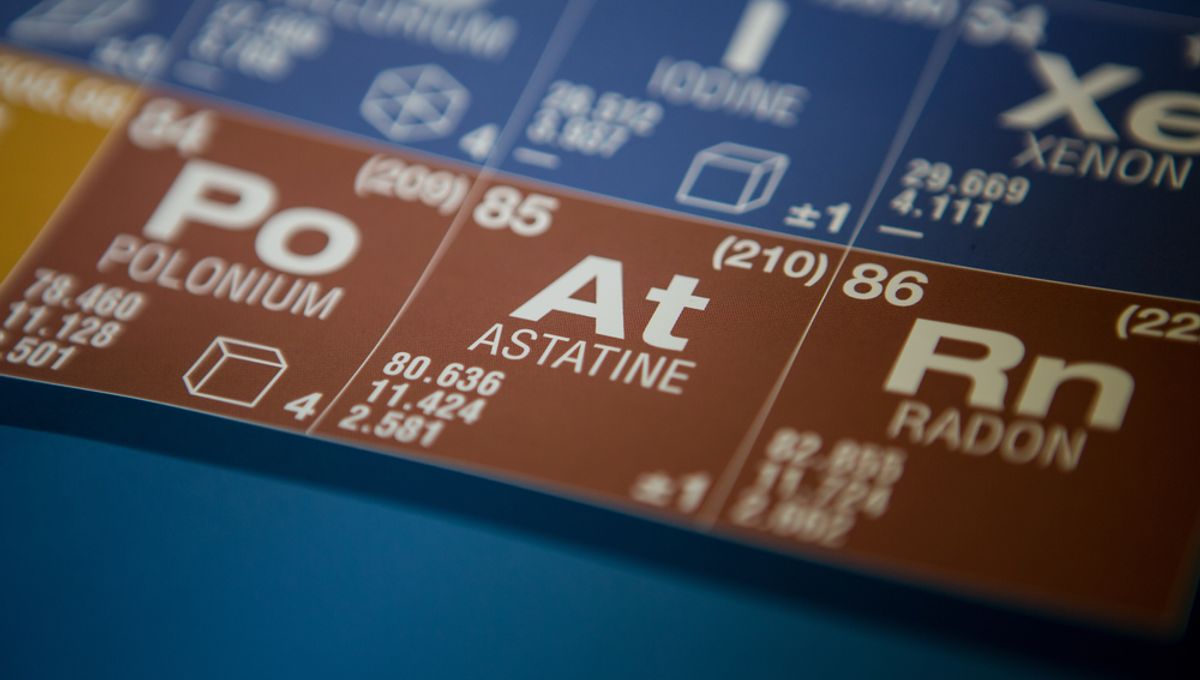
At last count, there are 118 confirmed elements in the periodic table – yet, out of that huge number, you’re more than nine times more likely to come into contact with just five than the other 113.
That’s because, out of all of the dozens of elements found in the Earth’s crust, it’s those five – oxygen, silicon, aluminum, iron, and calcium – which make up a total of more than 92 percent. In fact, almost half of the atoms we encounter every day are oxygen, making it by far the most abundant element on the planet.
At the other end of the scale, though, we have astatine: the rarest naturally-occurring element on Earth. It’s thought that less than 25 grams – that’s less than a single ounce – of the stuff exists planet-wide at any one time. In fact, it’s so rare that scientists still don’t know basic information about the element, like what it looks like.
Astatine is named after the Greek word for “unstable”, and it’s a fitting moniker: it’s incredibly radioactive, with a half-life of just over eight hours even in its most stable form, astatine-210. That means that even if you managed to get your hands on some, after 24 hours, just one-eighth of it would be left – the rest having decayed into either bismuth-206 or polonium-210.
And that’s the most stable isotope – most forms of astatine have half-lives of a single second or less. In its elemental form, things get even more volatile: it’s so radioactive that if you had enough to see with the naked eye, it would literally vaporize itself under its own heat.
While scientists are sort of able to deal with astatine directly, they can only do so by artificially creating it through nuclear reactions – usually by bombarding bismuth-209 with alpha particles.
Most of what we know about the element, therefore, comes from theoretical work rather than practical experimentation. For example, we think astatine probably looks like a black solid, because it lies in the halogen column of the periodic table. Halogens get darker as they get heavier: fluorine is essentially colorless, chlorine is yellow-green, bromine is red-brown, and iodine is dark grey-violet – hence, the logic goes, astatine, as the next halogen in the list, should be darker still.
Of course, that’s assuming the element isn’t in fact more like a metal than a halogen – a question that divides chemists, since astatine also lies along a diagonal line in the periodic table which contains metalloids like boron and silicon. In chemical reactions, it sometimes acts like a halogen and other times like a metal, resisting easy classification even by experts.
Despite being so rare as to be practically non-existent – and so confounding that we know basically nothing about it for sure – astatine may turn out to have some pretty important practical applications. As the element decays, it emits α particles: radioactive particles formed from a combination of two protons and two neutrons, which are, for various reasons, really good at targeting cancer cells.
“Astatine is the Goldilocks of α emitters,” Mehran Makvandi, a radiologist at the University of Pennsylvania’s medical school, told Chemical and Engineering News, a magazine published by the American Chemical Society, back in 2020. It emits fewer α particles than other isotopes like actinium-225, Makvandi explained – that makes it less potent, but more focused in its emissions. It has an extremely short half-life, meaning it won’t hang around for a long time. Importantly, it only emits α particles – the least harmful of the various types of radiation.
If scientists could attach astatine isotopes to cancer-targeting molecules, then, they might be able to create an anti-cancer treatment that could slice through the DNA of a cancerous cell, and leave the surrounding tissue relatively unharmed. When it comes to potential cancer treatments, Makvandi said, “nothing can even come close to having that same targeted potency.”
Of course, there’s a pretty big caveat to all that: researchers need to get their hands on the stuff first. Since it’s so rare and unstable, that’s no easy task – which may be why the element is still officially listed as having no known biological role or uses outside of research.
But maybe that’s for the best. After all, if we knew it was really important, we’d probably need a lot more than 25 grams of the stuff, wouldn’t we?
An earlier version of this article was published in March 2023.
Source Link: Earth's Rarest Natural Element Will Vaporize Itself If You Collect Too Much Of It